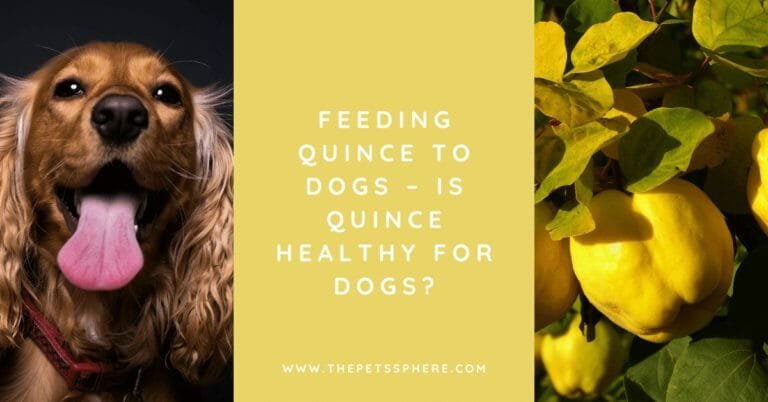Quince is an aromatic fruit of golden-yellow color belonging to the Rosaceae family. It possesses a hard and lumpy skin.
With its shape resembling a pear, quince is sour and is usually used to make jams, puddings, or alcoholic drinks.
Dogs being omnivores, do not necessarily need fruits in their diet. However, occasionally treating your pooch to a healthy fruit won’t do any harm. Does this include quince? Is quince fruit safe for dogs?
Can dogs eat quince?
Quince is safe for dogs as it offers a great nutritional value. Quince is low in fats and rich in vitamin C. It contains a high dietary fiber content and essential minerals like copper, potassium, iron, zinc, etc. However, the fruit carries a high amount of sugars, so feed it moderately to your pooch.
Before giving your pooch quince, make sure to remove the seeds. Quince seeds contain cyanide which is toxic to dogs.
Furthermore, seeds are hard to digest for the pooch and are a choking hazard.
Get rid of the leaves and stem, as they are also dangerous for the canine. After following these precautions, you can add nutrient-dense fruit to your dog’s diet.
What are the health benefits of quince for dogs?
Several nutrients present in quince are great for a dog’s health. Some of the health benefits of feeding your dog quince include:
Improved immunity
Quince possesses a high amount of vitamin C. This antioxidant defends the dog’s body against free radicals that destroy red blood cells. It also helps reduce any inflammation throughout the body. This leads to an enhanced immune function in the canine.
Vitamin C also protects dogs from several skin diseases, thus maintaining healthy skin and coat.
Healthy bowel movement
There is a large quantity of dietary fiber present in quince. It maintains a healthy bowel movement. Dietary fiber can be very helpful if the dog suffers from constipation problems. It can soften the stool, making it easy to pass. Moreover, it can also treat diarrhea by retaining water from the stool and solidifying it.
Aid against arthritis
Arthritis is a common health condition in pooches. Consuming quince can sometimes offer a little relief from the joint pain. Quince has around 197g potassium per 100g serving. Potassium is known to relieve arthritis pain in dogs.
Prevention of obesity
Quince is low in fats and calories. So, eating the fruit will not cause any unwanted weight gain. Furthermore, the high fiber content in quince makes a dog feel full and prevents overeating which is the main cause of obesity.
Protection from skeletal problems
There is around 0.13mg copper present per 100g of quince. Copper maintains several bodily functions in pooches. Copper, along with iron, aids in the formation of a healthy skeletal system in dogs.
Some other benefits of copper include maintaining the color of the dog’s fur. The mineral is also involved in the formation of myelin. Myelin protects nerves throughout the body. Copper also supports the body in the metabolism of iron.
How many quinces can dogs eat?
Fruits are usually high in sugar content. They should be given as an occasional treat to dogs. Quince, just like other fruits, should not account for more than 10 percent of your dog’s nutritionally balanced diet.
Eating excessive quince can cause bloating, diarrhea, abdominal pain, and cramping. It can also increase blood sugar levels in pooches which can further cause some health complications.
How to serve quince to dogs?
After removing the leaves, stem, skin, and seeds, quince can be served raw or cooked. You can peel off the skin and serve it raw to the dog. However, the recommended way is to cook the quince to soften it. Simply boil it in water and don’t add any sugars as the fruit already contains a lot of them.
Raw quince might not be appealing to a dog. It has a sour flavor with tough textured flesh that can lure the dog away from the fruit. Cooking quince will soften the texture, making it easier for the pooch to eat.
You can also freeze quince and serve it as a snack. This would work best on hot summer days. Another way is to directly add the fruit to your dog’s meals.
Related FAQs to quince and dogs!
Is flowering quince poisonous to dogs?
Fruits grown on the flowering quince bush are not generally toxic to pooches. They are safe to eat as long as you give them in moderation.
Can dogs eat quince paste?
Made from the pulp of quince, the sweet jelly is not harmful to dogs. However, it contains added sugars in it. So, you should give very little amounts to the canine.
How do you know when quince is ripe?
A ripe quince should have a bright golden-yellow color. It should have a strong flowery smell and not feel hollow upon tapping.
Is quince poisonous when raw?
While quince is still edible in a raw state, its astringent flavor combined with the tough flesh can make the dog not want to take a bite. It’s better to cook quince for the pooch.
Concluding my thoughts on giving quince to your fido!
Quince can be a healthy treat for pooches. The aromatic fruit packs a nutritional punch. While quince is generally safe for dogs in moderate amounts, a dog can have an allergic reaction to the fruit in rare cases. Consult a veterinarian immediately in such a case.
If your dog seems fine after munching on quiche, you can use it as an infrequent food option for your furry companion.

